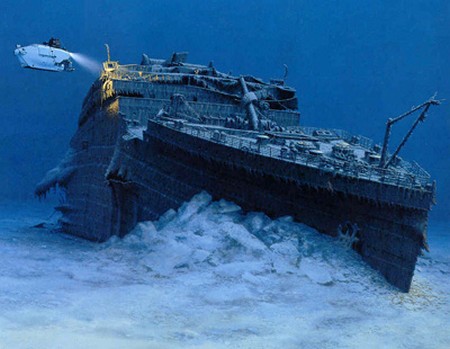The Titanic is probably the most legendary ship in recent history due to the scale of the project, its reflection of early 20th century injustices, and of course its ultimately tragic fate. The Titanic unfortunately remains famous one of the biggest maritime disasters in history. It continues to fascinate generations of scientists and history enthusiasts and has become a true cult topic. Science recently helped uncover some of its many mysteries when the wreck was discovered in 1985.
Construction
White Star Line, a major British shipping company, decided at the beginning of the 20th century that its engineers would build the biggest and most prestigious passenger ship in the world: the RMS Titanic. Thomas Andrews was in charge of the design, and construction began at the Harland and Wolf naval construction site in 1909.
The Titanic came toward the end of the steam-engine era and was an enormous ship whose size was intended to intimidate the competition. With over 880 feet of length (several times the size of a Boeing 747) and a tonnage of over 46,000 tons, the RMS Titanic was at the time the biggest ship ever built, carrying 3547 people in total.
The ship was meant to dazzle both with its sheer size and its luxury aboard. Engineers took pride in having built a fast and strong ship that would take high-end passengers across the Atlantic in style.
Life Aboard the Titanic
White Star Line had made a point of designing the most luxurious and sometimes over-the-top infrastructures possible to accommodate the very wealthy first-class passengers. Amenities were numerous and included a high-end restaurant, a swimming pool and a sports center. Second-class passengers had much more common traveling conditions, while third-class passengers were simply on board to get to the other side.
Inaugural Voyage and Sinking
The Titanic’s tragic ending occurred during its first and only voyage, which started April 10, 1912, from Southampton and meant to end in New York City. The ship carried a total of 2228 people of all walks of life, nationalities and social backgrounds. Edward John Smith, an experienced British captain, was in charge of the ship for what he intended to be his final trip before retirement.
The inaugural voyage of the Titanic was a major event that drew a host of English and American celebrities and businessmen, among which were Dorothy Gibson, John Astor, Benjamin Guggenheim, Isidor Straus (Macy’s co-founder) and many others.
The Titanic‘s sinking occurred in the night of April 14, 1912, four days into the journey, when the ship collided with an iceberg and its floating compartments gradually filled with water until they couldn’t support it anymore. It took almost three hours for the Titanic to become completely submerged, but poor decisions and lack of preparation led to the deaths of 1522 people out of the 2228 present on the boat.

The biggest cause of outrage in the tragedy is undoubtedly the lack of lifeboats, coupled with the priority given to first-class passengers during the evacuation. Amazingly, White Star Line had not deemed it necessary to equip the ship with more than 16 lifeboats, which amounted to a capacity of only 1178 people. Those lifeboats were also grossly underused and helped rescue only about 700 people, while the rest perished in the freezing waters.